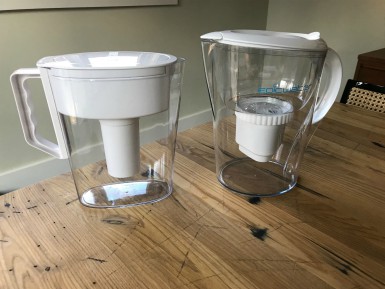
I’ve been a long-time user of pitcher-type water filters; my old Brita filter has had probably hundreds of gallons put through it. The filtered water it produces tastes better, and I like the fact that it pulls a few nasty items out of the water my family and I drink every day. Without a doubt, I am a big proponent of filtered water. After using my Brita, I feel uncomfortable drinking unfiltered water. Call me pretentious, but I would rather not consume strange heavy metals in my water.
However, I recently received an EPIC Pure Water Filter pitcher-type filter in the mail for a review. It was a great opportunity to do a little research, and see if the newer, more impressive-appearing EPIC offering was a better product than the tried-and-true Brita product that I’d been using for years.
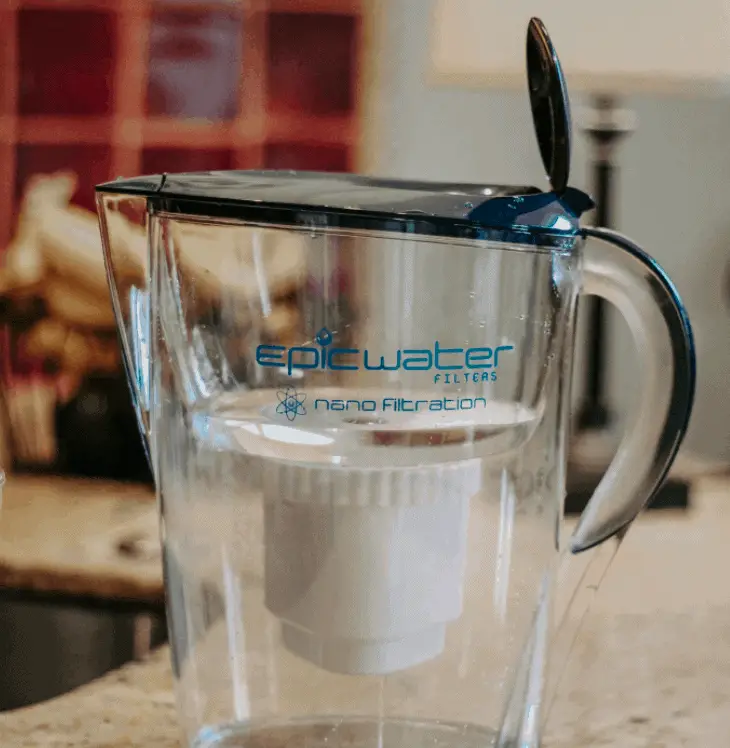 #1 Pitcher
|
|
Check Latest Price |
SKIP AHEAD
Why use a water filter every day?

In a SHTF/survival-type situation, water filtration is a no-brainer. Assuming the power grid is down, any water you can source that isn’t bottled can be assumed to be contaminated with some sort of offending nastiness, and absolutely should be filtered and purified. However, in day-to-day life, it’s easy to become complacent about the water that flows from your faucets. We take it for granted that the water has been made safe for us to drink by the unknown people at the water treatment plants. We turn the tap on, and we blindly think that what comes out MUST be okay. But that “okay” water was processed with additives such as chlorine and aluminum sulfate, fluoride was probably added, and then it ran through miles and miles of metallic pipes underground, where it then makes the trip to your domicile, through the iron or copper plumbing that’s probably joined with lead solder, coursing out through the faucet that has bacteria living happily inside. Most people don’t think about it, and I’ll admit I never did until I started doing research for this article.
Related: Trace Pharmaceuticals and Water
My house has city water supplied to it, and though the water company sends out yearly reports on water quality, the list of agents listed on the report definitely makes me take pause. Yes, at the time of the report, the water quality is hunky dory – but how quickly can this balance be upset? If something goes awry at the water treatment facility, how much water will run through my house and my family before the problem is caught and addressed? Will the powers-that-be even let me know there is/was an issue with my water?

Now, I know that the people who are employed by the city to maintain the water supply used by thousands are highly qualified and trained to ensure that I have safe water that flows out of my faucets. I also know that the Safe Water Drinking Act means that there are federal standards, regulated by the EPA, so that my water meets quality standards. The EPA monitors the water for many organisms, bacteria, metals, chemicals, and other contaminants that can make you sick, give you cancer, or make life generally completely unpleasant in a multitude of ways. However, the EPA doesn’t regulate many water-borne items, such as aluminum, chloride, and copper. In large enough quantities, these items and others that may still be in your water can do funky stuff to your systems.
Wells aren’t immune to contaminants either; pesticide runoff, petroleums, MTBE, metals that occur in the ground, bacteria, and other nasties can find your way into your dug or drilled well. Again, most people don’t consider these issues once they have their well installed and tested – if everything is reported as fine, people run on automatic and think the water will always be fine.
All this being said, here in the USA and other developed countries, it’s safe to say that usually your water meets minimum standards for safe drinking water. However, it’s also safe to say that you’re getting some additional unhealthy contaminant passengers along for the ride – no matter what the yearly water reports from the city water department say.
The Ins and Outs of Water Pitcher Filters
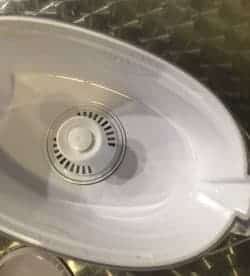
So, me being the slight alarmist that I am (you have to be to run with this crowd, right?), I try to play it safe and drink filtered water, if it comes from my tap. I don’t have the space or funding to really hook up a high-end in-line pre-faucet water filter, so I choose to run a pitcher-type filter for my drinking water needs. It’s an easy, inexpensive way to keep clean water available. Fill the pitcher, stick it in the fridge, and let it do its thing. It’s easy for the whole family to do (provided the teenagers remember to fill the pitcher back up after they use the last of the water), so it’s a nice, simple, foolproof way to keep a half gallon or so of clear, clean-tasting water ready to go.
Basically, the way a pitcher-type filter works is simple: open the lid, located at the top of the pitcher. Pour your to-be-filtered water in the top, straight from the faucet if you’d like. Put the lid back on, and let the pitcher work its magic. Water is pulled from the reservoir at the top of the pitcher by gravity, coursing the H2O through the filter(s) located underneath the reservoir. The inside of the filters contain any number of elements – almost always activated carbon is involved; Brita uses coconut shell-derived carbon. Activated carbon, if viewed through a microscope, is porous and covered in lots of crevices that attract and hold impurities and contaminants through a process called adsorption.
Activated carbon works pretty well to eliminate a number of nasties in your water, such as chlorine, and some pesticides and some solvents – this is why activated carbon is commonly used in fish tank filters. However, activated carbon eventually reaches its holding capacity and no longer can be used to reliably filter water eventually, so the filter must be replaced at periodic intervals. Other elements can be added to attract and reduce or eliminate other contaminants – but after quite some time searching the web for research on what these elements might be, it seems that most water filter manufacturers play their cards pretty close to the vest, leaving us to wonder at the magic of proprietary water filtration processes.
Since water pitchers function by pulling water through filters via gravity, there is generally not enough pressure to purify via reverse osmosis, and many bacteria can still get by – so it’s not recommended that you use pitcher-type home filters to cleanse water from streams, lakes, rivers, mud puddles, or the like. Sediments and contaminants will be filtered for sure, but you can still get sick through bacteria infestation. Dedicated outdoor-type water filters are recommended for naturally-sourced water filtration.
The EPIC Pure Water Pitcher Filter System Review
I, for a while, thought I just had a standard pitcher type filter. However, upon digging about, I was excited to find that I had been sent the new EPIC Pure Pitcher.
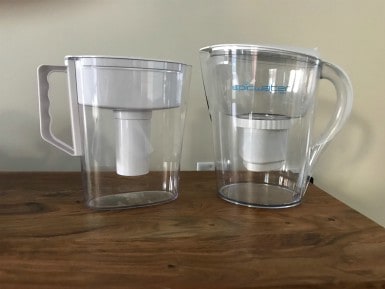
The Pure is like a Brita only for survivalists or preppers. My EPIC Pure pitcher filter features a large, replaceable filter and a pitcher that holds, by rough estimate, three quarters of a gallon or so of water. The filter supports about 200 gallons of water filtration (my Brita does 40). The filter elements and pitchers are 100% BPA free, and the filters themselves are 100% recyclable, which means that over the lifetime of the filter, you have potentially saved using 1,500 plastic water bottles – a definitive environmental impact.
EPIC boasts that their filters will remove up to 99.99% of contaminants that can be found in tap water. I investigated their website to see what they actually remove, and the list is ridiculous: most are contaminants, and pesticides are things I’d never heard of but sound awful, and the metals removed list includes chromium 6, aluminum, mercury, lead, arsenic, TTHM, and Radon 222, among other things. I won’t throw the full impressive list on this post, but definitely check out the list of what the EPIC Pure filter keep out of your body.
 #1 Pitcher
|
|
Check Latest Price |
The Pure’s Competition
I’ve used a Brita pitcher filter for years, as I stated at the beginning of this article. Mine is a Brita Water Filtration System, the same model you can get online or at Target or Wal-Mart. Brita has the market cornered on accessible, household name pitcher filters. The Brita is an affordable pitcher filtration for the masses and 100% made in China.
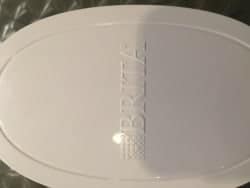
The Brita features replaceable filter cartridges, and they last approximately 40 gallons per filter, according to Brita’s website. However, the Brita offering really concentrates on improving the taste of the water, instead of actually doing a really thorough job purifying. Accoding to Brita, the pitcher filters they offer just remove or reduce chlorine, copper, cadmium, and mercury. There is no mention of filtering out pesticides like DDT, or other common contaminants and metals such as lead. Brita does offer products that remove more contaminants, but not in the pitcher format we are analyzing here.
Battle Royale: EPIC Pure vs Brita Water Filtration
So in the interests of doing a straight apples-to-apples test, I bought a brand new Brita filter cartridge from Amazon, and performed the standard pre-soak that Brita requires. I loaded up the new filter in the Brita, and filled both up with straight tap water. The larger EPIC reservoir took almost 15 minutes to filter. The Brita was much faster to process, probably just five or six minutes. But in both cases, the water that was produced was crystal clear, and devoid of any of the slight chlorine smell that my city water usually has.
I went all Mythbusters on my taste test, and filled three glasses with water: one glass with tap water, one with water from the Brita pitcher, and one with water from the EPIC pitcher. I had my wife and son each try out the water, and report which glass they thought was from each aquatic offering. I then asked them to do the same for me. The results? The tap water was a gimme; its taste and smell was very distinct, with the rather not-great metallic chlorine taste. All three of us nailed which glass held the city-fed tap water.
As for the filtered water, my wife and I both were able to distinguish the EPIC filtered water, but I can personally tell you that the taste from both the EPIC and Brita products were quite close: clear, with no metallic or chlorine tastes – and very, very good. There was no smell from either glass.
Video
Where the EPIC filter really made a marked difference in taste was in coffee, believe it or not. The EPIC filtered water definitively produced much smoother, rich-tasting coffee from my home coffee maker. I have no science to back me up, but I am theorizing that the pH-modified alkaline EPIC water knocked back on the acid produced from the coffee, and the resulting beloved caffeinated product was far superior as a result.
So, Brita or EPIC? The Brita absolutely produces excellent-tasting water, and filters out a few undesirables in the water stream. But, if you can afford it, the EPIC offering is certainly a better product for the environment – its filters last 2 ½ times longer than the Brita offerings and are recyclable. The EPIC filter is certainly better for you and your family. If you buy bottled water to drink around the house because your well or tap water is unpalatable or unsafe, the EPIC will pay for itself in very little time. The EPIC pitcher is more expensive, and the replacement filter cartridges are also pricier (Made in the USA – yes, they will be more expensive). Yes, it’s pretty expensive – but the EPIC has something else going for it that makes it worth every penny, in my humble opinion.
 #1 Pitcher
|
|
Check Latest Price |
Health Benefits
I mentioned earlier that I had perceived health benefits from my switch to drinking water from the EPIC Pure pitcher, and it’s true. I have a condition known as GERD (Gastroesophogeal Reflux Disease) where the muscle at the junction of the esophagus and stomach relaxes, allowing built-up acid to splash up into my windpipe and lungs, causing severe heartburn and general chest discomfort, along with irritated lungs. GERD’s onset for me is usually stress-related and is exactly as much fun as it sounds.

Once I received the EPIC Pure water pitcher, I immediately started using it for all the water I drink. Within a couple days, I noticed a huge difference in the amount of heartburn and windpipe discomfort I was experiencing. At first I attributed it to a switch in coffee brands I made at the same time I received the EPIC filter; I did not know that the EPIC was a Pure pitcher with pH benefits because they use activated coconut carbon filters which are alkaline. When I brought some of the new coffee (from Main Gun Coffee Company – DEFINITELY check them out if you’re a coffee aficionado) to work for use at my coffeemaker there, I had acid issues kick in again. There went the coffee theory.
However, when I started doing research for this review, I realized what which product had been sent to me, and the gears turned. The GERD symptoms definitely lessened right when I started using the filter, and when I drink water from other sources, sometimes I’ll have issues. So, it is my personal postulation (that is purely my own conjecture and could be completely wrong) that the alkaline pH levels that the EPIC Pure water pitcher introduces reduces acids that the body produces, driving down my heartburn symptoms. Take it for what it’s worth to you, but I believe the EPIC Pure product to really work, and has positive health benefits that go beyond eliminating contaminants and nastiness from the tap water I drink. It tastes great, makes bitchin’ coffee, and I feel better. Winning.
Wrapping It Up
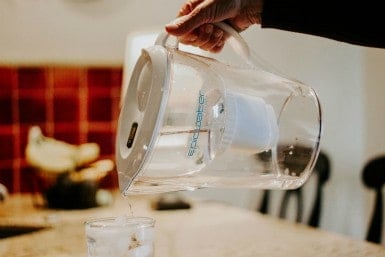
The EPIC Pure water pitcher is great, whether you just want clear safe water, or you’re looking to try health solutions that go beyond pumping pills in your face. The initial sticker shock is a definite turn-off,and I’ll admit to you that when I got the filter and I looked into what using it would cost me, I rolled my eyes and uttered a “yeah right.” But I’ve used the pitcher extensively, comparing it to a very common competitive filter, and I’m now a true believer in this filter.
For those of you who don’t want to take the hit on the Pure system, EPIC also offers a full line of other outdoors-rated filters, including the Stainless Steel Travel Bottle that allows you to drink from almost any water source you can find. If you’re looking to try the next level of personal home water filtration, and don’t want to invest in under-sink in-line plumbing filters or clunky faucet add-on filters, be sure to look at the EPIC Pure pitcher filter system. It’s head and shoulders above the competition, and you’ll feel better for it as a result. What are your thoughts? Is the 70 dollars for a home tap water filter too much, even if there are health benefits besides hydration? Do you use something different? Sound off in the comments below!
 #1 Pitcher
|
|
Check Latest Price |

